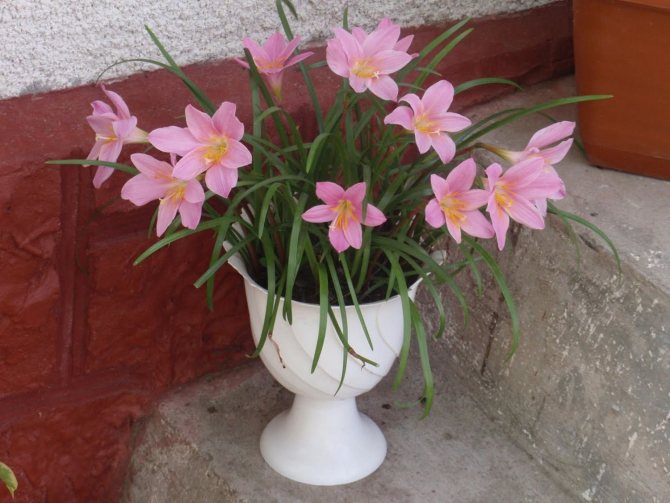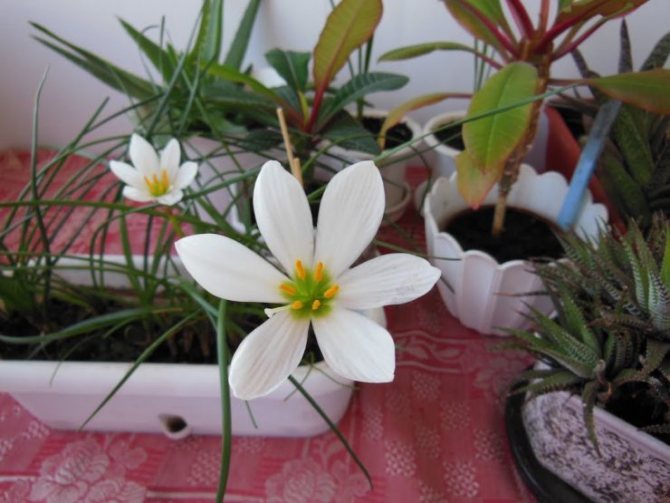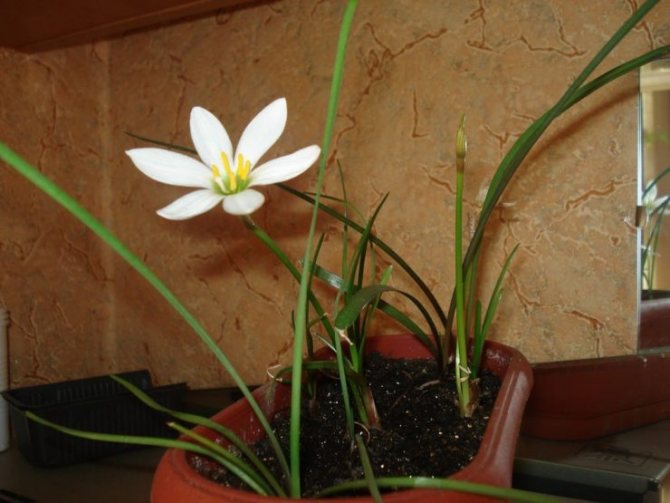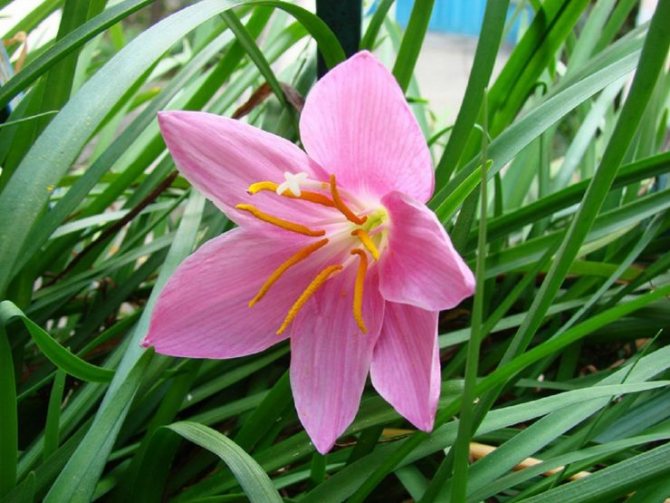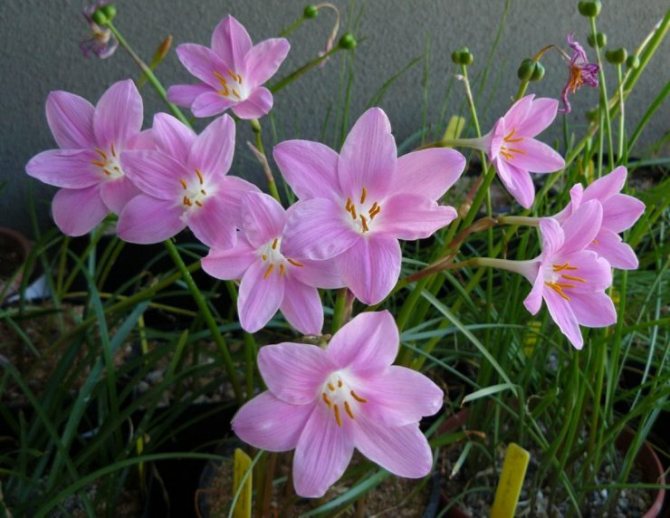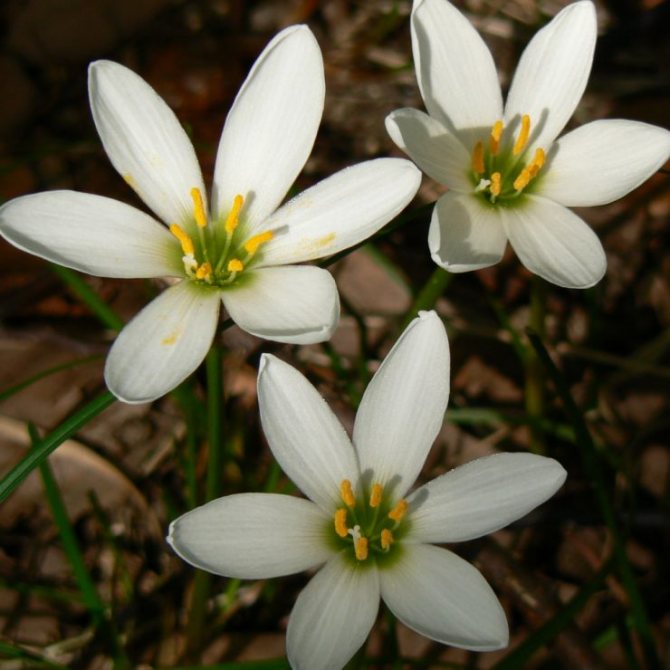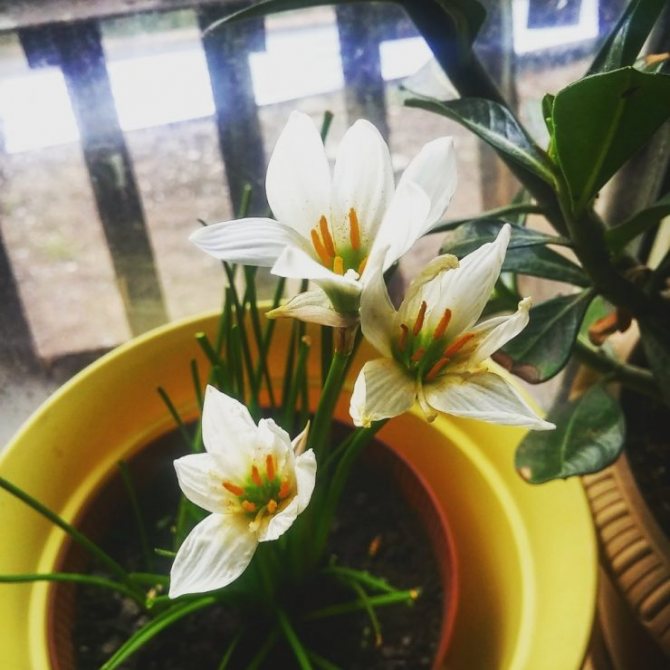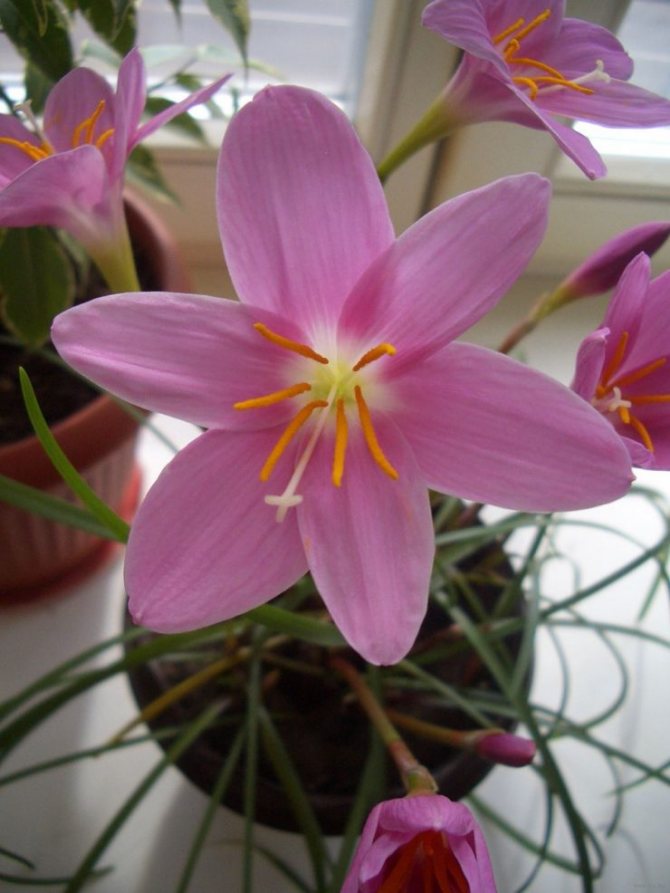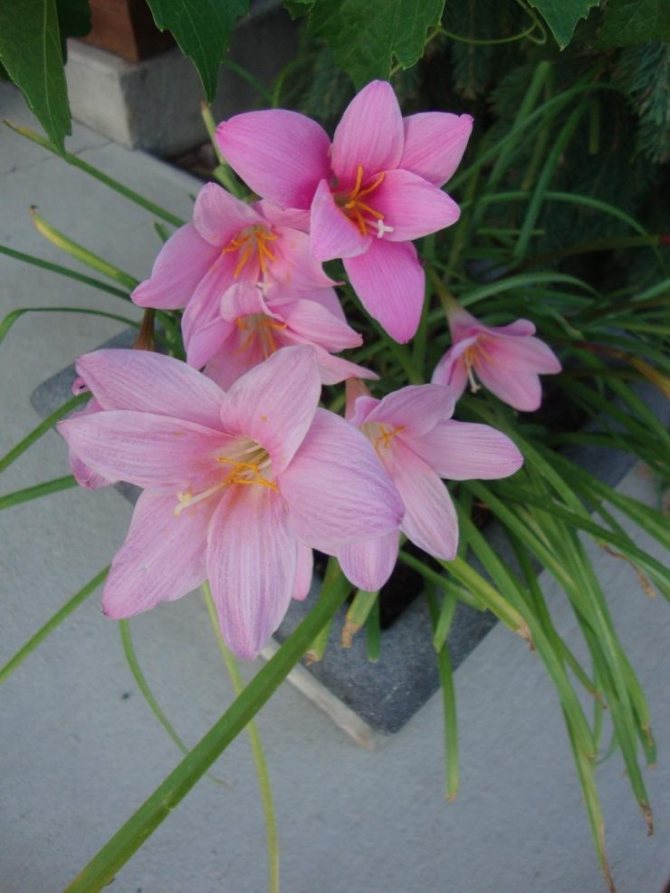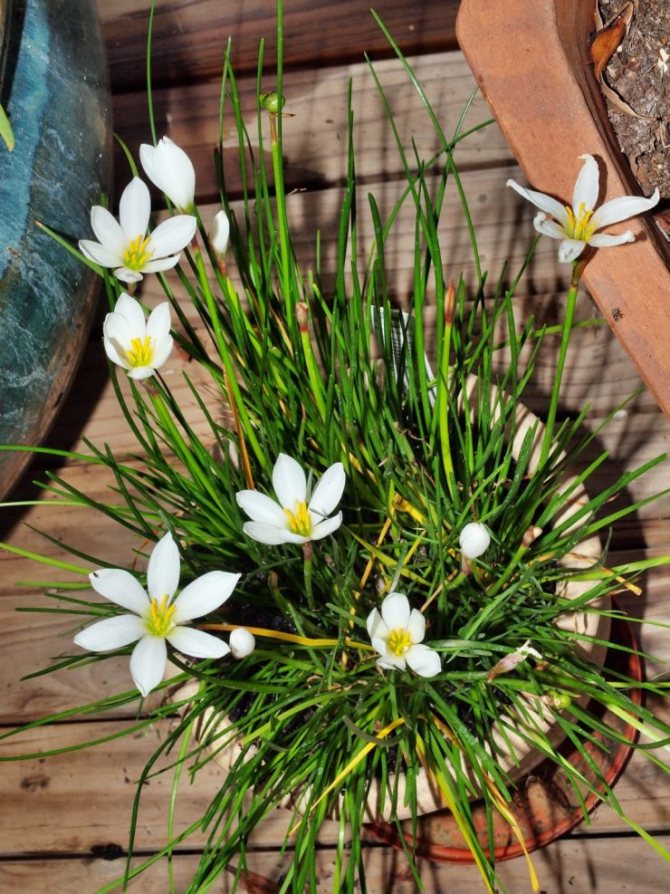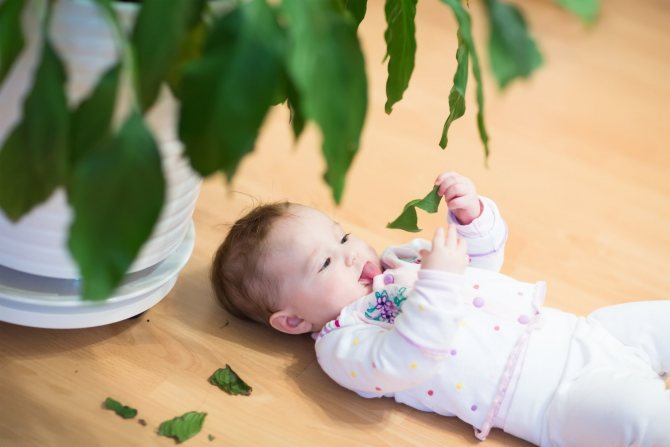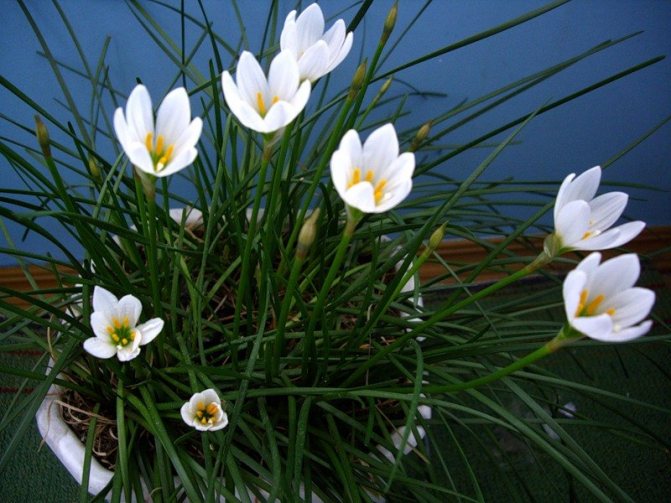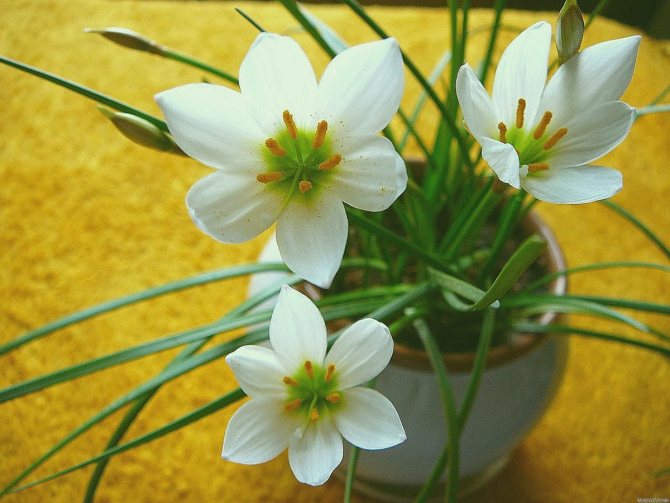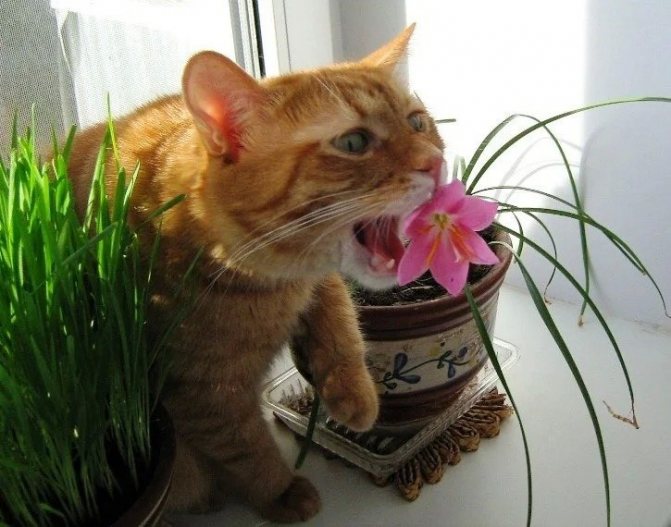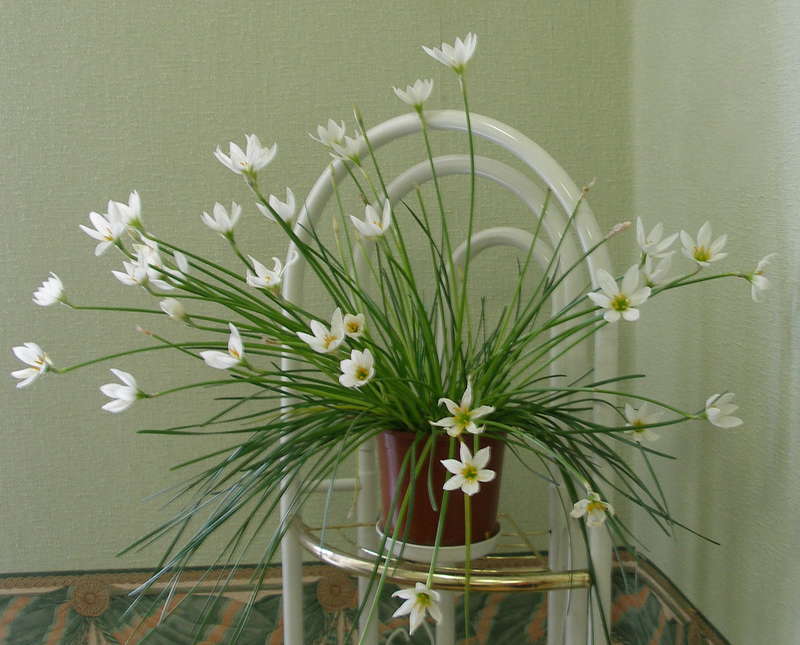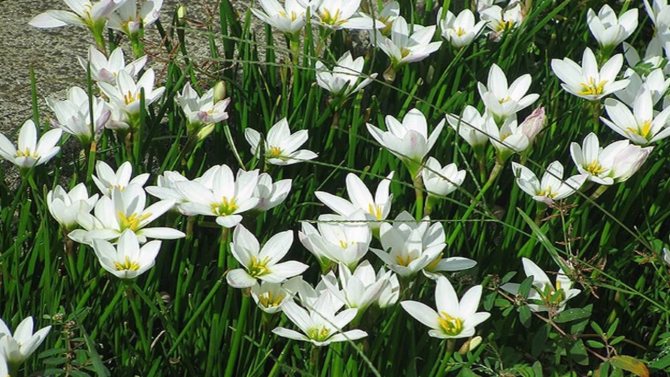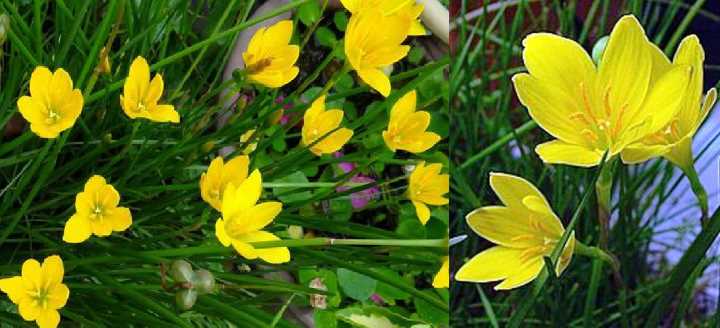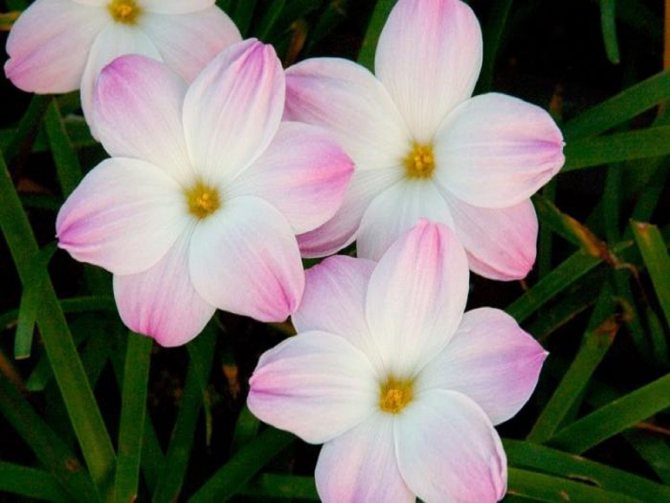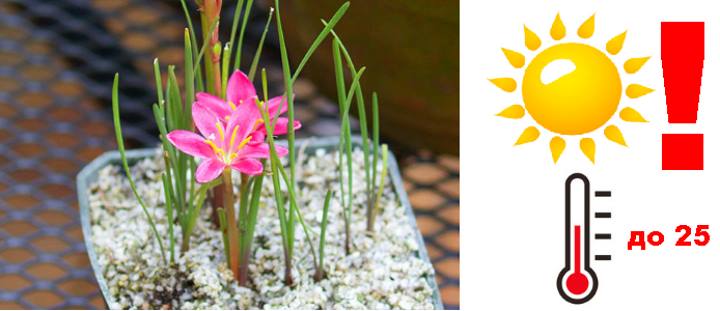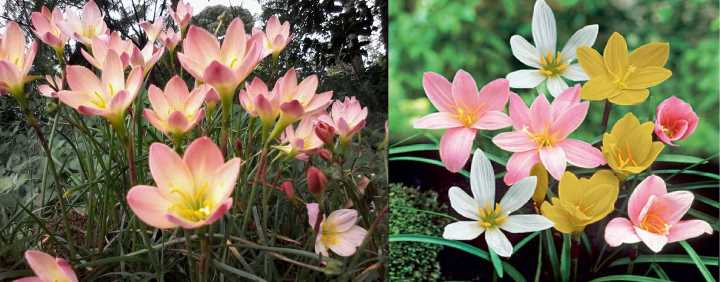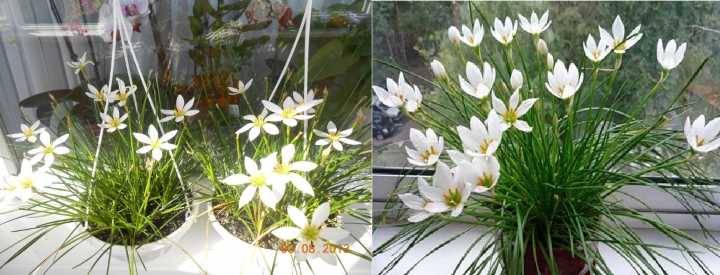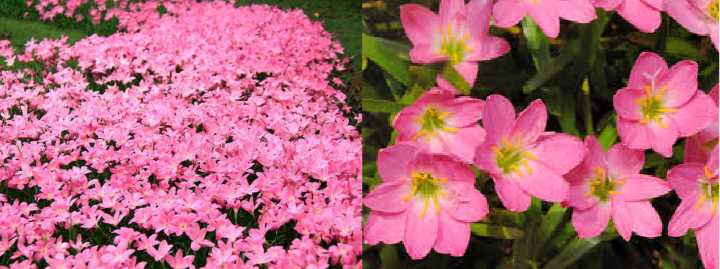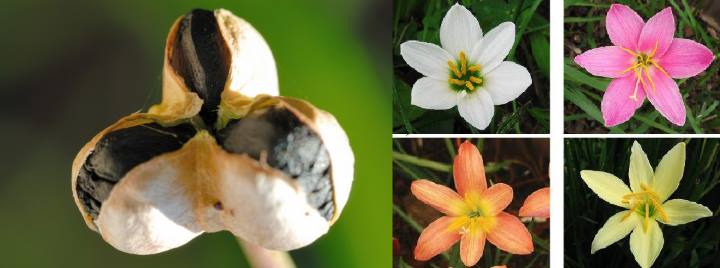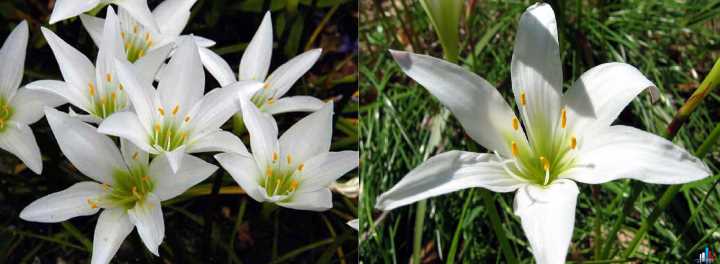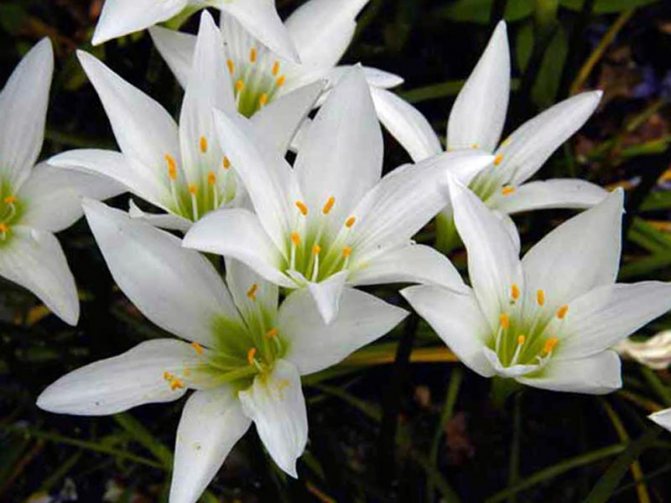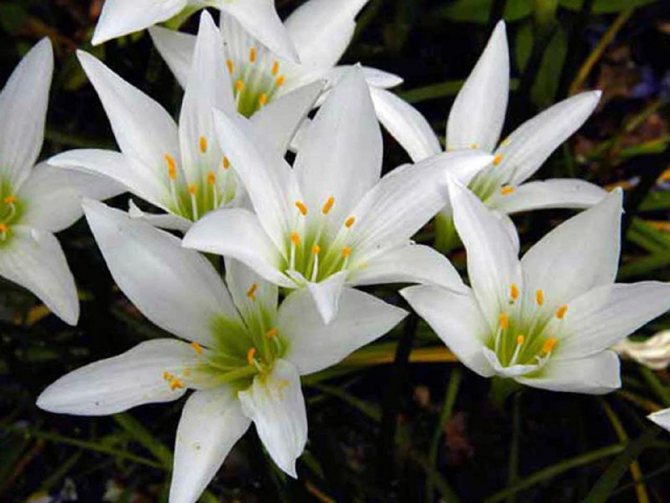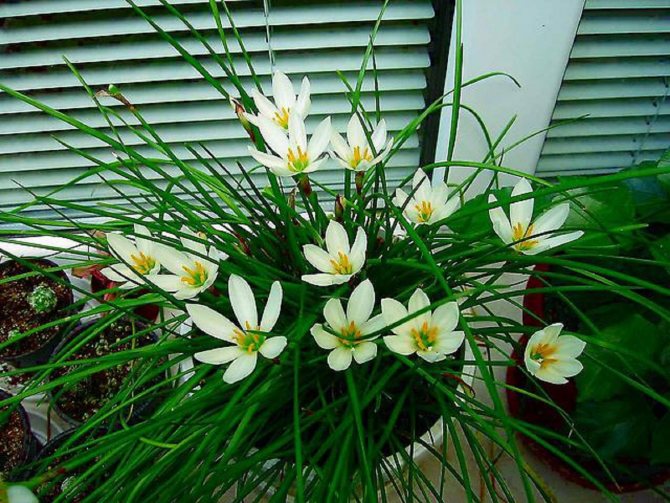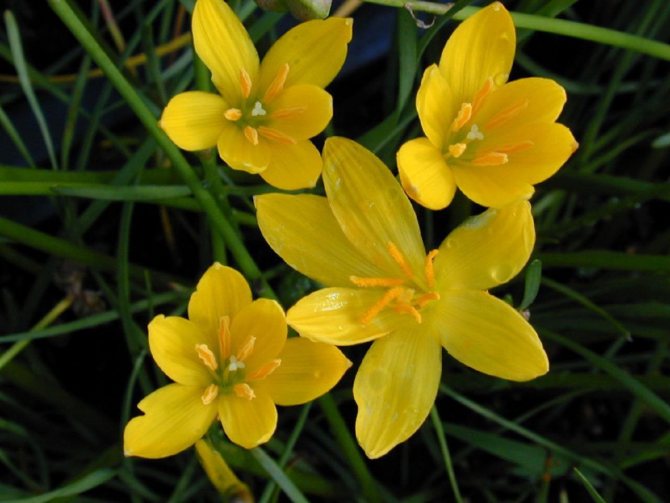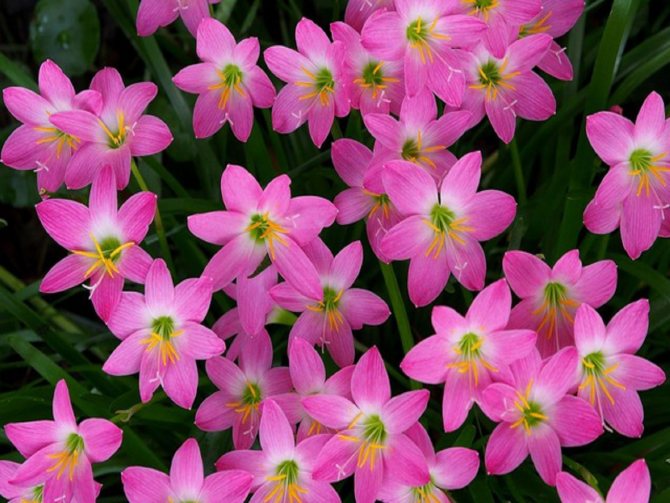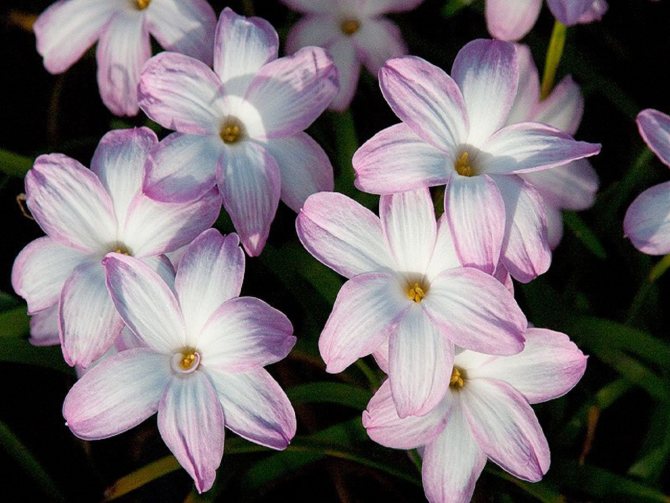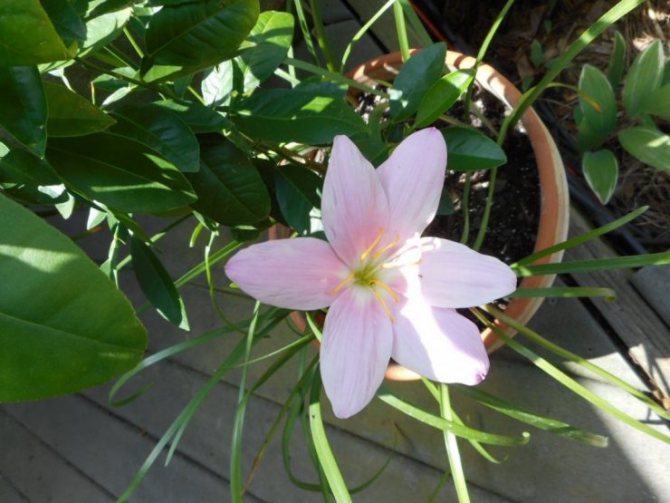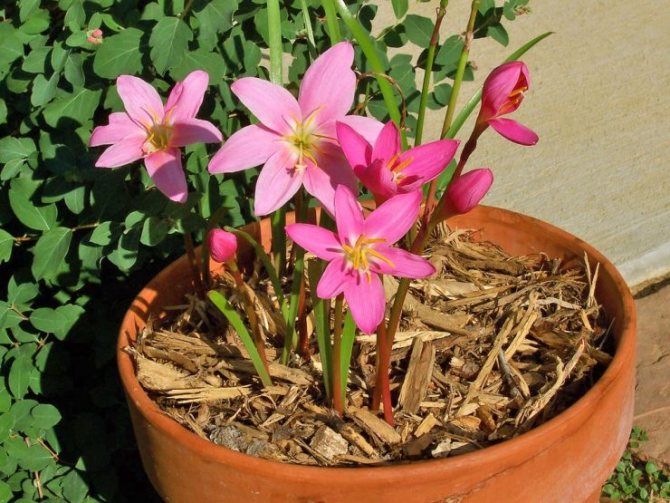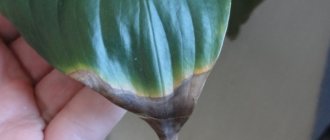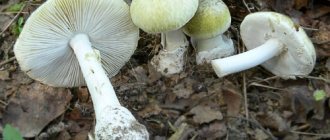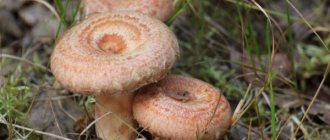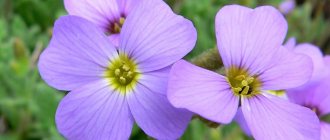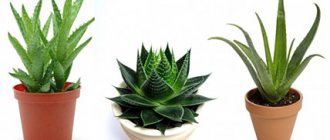Zephyranthes bears in its name the name of the mythological Zephyr - the god of the west wind. Also, this flower, originally from the tropical forests of Central and South America, was nicknamed the rain lily. Both of these romantic names can be explained quite simply: in their homeland, most representatives of this species bloom at a time when the wind changes to the west, bringing rains with them. Such weather conditions are fine with this flower.
In another way, this flower is also called an upstart, because it blooms extremely quickly and completely unexpectedly: in just a couple of days, an arrow that has hatched from the ground grows and is already blooming as a delicate flower.
At first glance, it looks like a snowdrop. Not surprisingly, these flowers originate from the same amaryllis family. In the wild, you can find about forty species of zephyranthes, all of them have narrow dark green leaves and delicate flowers.
A single bulb usually produces several tubular stems up to 30 cm in height. They are decorated with single wide or not very wide open flowers.
Different types of zephyranthes bloom at different times: some in spring, others in summer, some bloom even in winter. Their petals can be white, red or pink, and flowers can also be double-colored. Someone compares the flowers of zephyranthes with crocuses, but apart from external similarities, there is nothing in common between these representatives of the flora.
Can Zephyranthis be kept at home?
There is an opinion that an upstart flower cannot be kept at home, let's see why. The only thing that comes to mind is that this is due to its toxicity.
All parts of Zephyranthes are poisonous! Position the flower pot out of reach of children and pets.
A much less weighty reason is the Feng Shui prescriptions, which read: at home you need to keep flowers with rounded petals. Whereas zephyranthes, and this can be seen in any photo, is distinguished by pointed petals, which means that it carries Yang energy - a rather heavy and difficult to control male, active energy. If you place the "Yang" plant incorrectly, it can harm energetically, but with the right approach, it will only benefit.
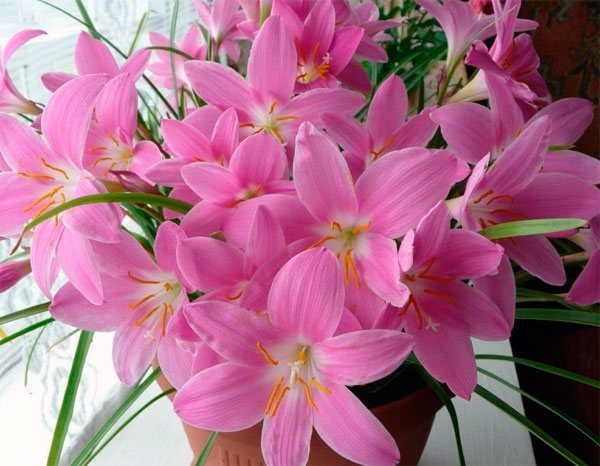
So, flowers with sharp petals, including zephyranthes, are not recommended to be placed in the bedroom (as, indeed, any indoor plants in Feng Shui). The best place for them is a living room or study. Here the active energy of the upstart will be very useful.
Video: why some plants are dangerous
For an adult, zephyranthes is not a real danger. If the premises are not visited by creatures encroaching on the inviolability of green pets, then there is no objective reason to refuse to acquire such a delicate and airy flower.
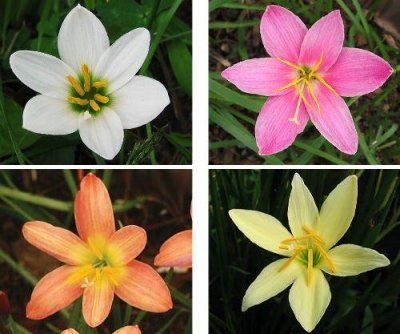

"Zephyranthes" (Upstart) refers to perennial herbaceous small-bulbous plants the amaryllis family.
In natural conditions, the place of its growth is South and Central America (humid tropics and subtropics).
The official name of "Zephyranthes" is translated as "Flower of the west wind".
Apparently, this is due to the fact that in the wild it appears from the ground with the onset of the rainy season, when the west wind begins to blow (Zephyr).
Another name "Upstart" he received for the fact that it is surprising grows quickly and blooms. Only a few days pass from its appearance to the beginning of flowering. And what is the other name for the flower "Upstart"? There are many options: "Rain" or "Water Lily", "Rain Flower" or "Home Daffodil".
Tips for those looking to buy Zephyranthes
An upstart flower can be easily purchased at any specialty store. No special knowledge is required for this: choose a sturdy, beautiful flower with clean leaves and intact stems.
It is advisable to choose a specimen with barely blossoming buds so that it delights you with its flowering as long as possible. However, this is not necessary: any purchased zephyranthes may well bloom in your home soon after purchase.
To know when to expect the long-awaited appearance of flowers, consult with the seller: find out what kind of species it is - what time of year it blooms and whether it sheds leaves after that. Thus, you will be able to provide the flower with optimal care that meets its requirements (after all, they are different for each species), and you will not needlessly worry about the natural fall of leaves.
The marshmallow of your choice may need to prune the leaves before the dormant period - this can contribute to better flowering, but not all members of the species require such measures.
The upstart houseplant does not really like frequent transplants, so if the store pot currently matches the size of the flower, do not rush to move the plant to another.
Prices for an adult flower start at 100 rubles. Further, it all depends on the rarity of the type and size of the flower.
Popular types of indoor zephyranthes
Zephyranthes robustus (or robusta, aka powerful zephyranthes) is one of the most common types of upstart plant, considered the standard of decorativeness among zephyranthes. Therefore, on its basis, many hybrids were bred, including varieties with special semi-double flowers.
Leaves - dark green, glossy-shiny, grooved, collected in a kind of rosette like a fan. In height, zephyranthes robusta can grow up to 20-30 cm, and bloom from late spring to autumn, releasing several peduncles in turn.
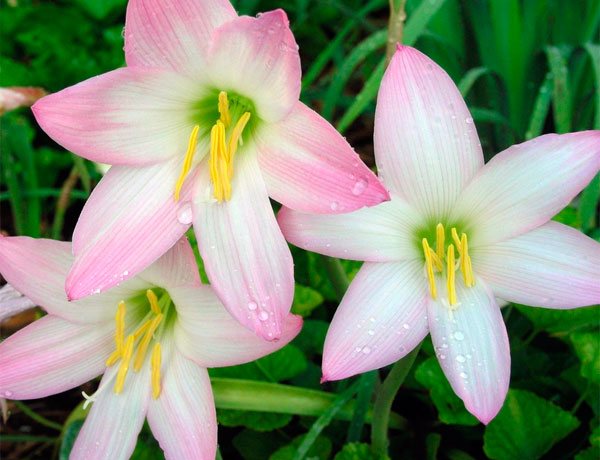

Its flowers have a delicate, subtle scent. Pointed petals are pink with a lilac tint and a soft or hot pink corolla, visible in the photo. They resemble wide-open funnels and are large enough in size so that the peduncles droop slightly under their weight. At the base of the upstart robustus flower there are two fused brownish bracts.
White Zephyranthesshown in the photo are divided into several types. For example, Atamas Zephyranthes has 4-6 narrow-linear dark green leaves and white flowers consisting of lanceolate petals. They bloom in early spring.
The egg-shaped bulb has a short neck, which means that when planting, it can not be left hanging above the ground. The Atamas upstarts feel best in cool rooms.
White zephyranthes is also represented by another species, which is called snow-white (zephyranthes candida). Its long tubular leaves appear at the same time as flowers. The stalk of the peduncle grows up to 20 cm in length. The flower petals are also spiky, mostly white, but in some cases the outer side may have a reddish tint. The perianths are funnel-shaped. Flowers can appear over a long period of time between July and October.
You can recognize this type of upstart already by the bulb: it is round in shape and has a long neck. Snow-white zephyranthes will also feel great in a cool place.
Zephyranthes golden is a representative of the genus yellow-flowered.Like all previous representatives, it is a perennial with linear leaves. In warm countries, it is often grown on soil, but in Russia it is kept in rooms where conditions are cool. The bulb of this variety is something between an ovoid and a round shape.
It is noteworthy that golden zephyranthes blooms in winter - in December or January. Its flowers are funnel-shaped, widening in the middle, and bright yellow.
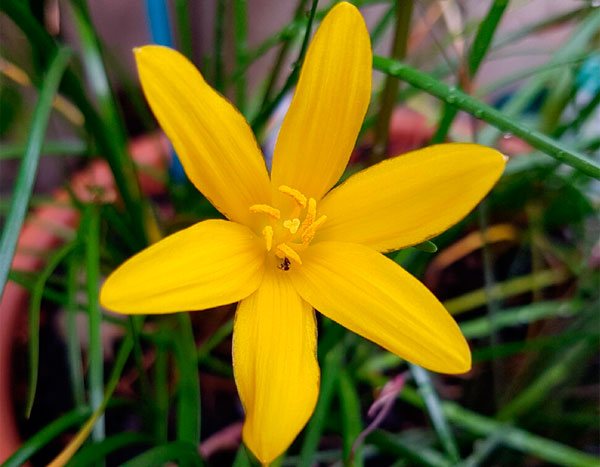

Among pink varieties (referred to as zephyranthes pink), the large-flowered Zephyranthes (grandiflora) is famous. Its bulb is ovoid and has a short neck. Narrow and long green leaves with a dark shade have grooves. And single flowers blooming on high (up to 30 cm) peduncles are pink.
They have a coronal perianth and orange stamens. This beauty can be admired in the second half of spring or early summer. And the dormant period for Grandiflora lasts from September to November.
Pink zephyranthes can also belong to the multi-colored variety (versicolor). It grows from oblong bulbs, producing long linear leaves and erect flowers. Inside they are white, and the outside of the petals has a reddish-green tint.
This variety also belongs to the "winter" and blooms in January. It feels equally good both in warm and cool rooms.
Reproduction
Reproduction of "Zephyranthes", like all bulbous plants, is easiest to carry out using daughter bulbs (children). You can also do this with seeds.
Seed
Growing "Zephyranthes" from seeds is quite possible, but due to the laboriousness of the process in indoor breeding, it is rarely used. In addition, the flowering of such plants should wait three to six years.
If the urge to experiment is still great, then you can try. For this, it is best to use seeds obtained by yourself through artificial pollination.
Sowing need to produce immediately after ripening of the capsule fruit and collecting planting material, since the percentage of its germination drops very quickly.
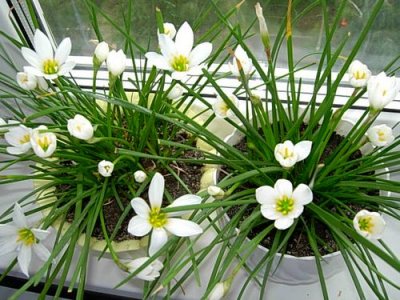

For planting, you need to take a wide bowl, fill it with drainage and soil, which must be well moistened.
The seeds are spread over the soil surface at a distance of two to three centimeters from each other.
Landings are closed with a film made of polyethylene and are placed in a room with good lighting and an air temperature of about twenty-two degrees.
Shelter is needed shoot for ten to fifteen minutes daily, to ventilate and moisten crops. Seedlings should be expected within a month, after their appearance, you need to remove the film. You should not plant too small seedlings, you need to let them grow well.
Daughter bulbs (babies)
This breeding method more simple and efficient, than the previous one. During a year of growth, each bulb can form up to fifteen babies. Therefore, during transplantation, they must be carefully separated from the mother plant and used for reproduction.
In a prepared bowl from five to ten bulbs are planted, those that are too small and have a short neck are completely buried in the soil, while those with a long neck should remain on the surface.
What care does a zephyranthes need at home?
The upstart home flower loves bright lighting, so it has nothing against direct sunlight. True, you should not expose it to such intense illumination for too long - a bright, but diffused light will better provide. Zephyranthes will be comfortable on any window except the north one. For the summer, the flower pot can be taken out into the street - a balcony or a summer cottage.
You can find out why Kalanchoe leaves turn yellow, and what needs to be done in this case, from this article.
And here is a detailed guide on how to care for the Kalanchoe at home.
You can find out what medicinal properties are inherent in the Kalanchoe plant from the material at this address:
When caring for zephyranthes, it is necessary to maintain the temperature: 18-25 degrees Celsius in summer and 10-12 degrees above zero in winter, during rest. It must be remembered that cold below 5 degrees Celsius threatens the flower with deathso it's important not to let it freeze.
If the upstart has dropped the leaves for the winter, it must be placed in a dark room. It will be possible to return it to its favorite illuminated place in the spring, when the active period of development begins. A plant that does not shed its leaves for the winter does not need to be removed in the dark, but it is necessary to ensure proper coolness.
In summer, zephyranthes require moderate watering: the soil should remain moist - not overdried, but not wet either. Watering frequency depends on indoor humidity and season. The most correct thing is to observe the state of the earthen coma, and as soon as its top layer dries up, you can start watering. Water should be poured in small portions so that the entire soil is saturated evenly. In winter, zephyranthes should be watered sparsely, only slightly moistening the earth to prevent the bulbs from drying out.
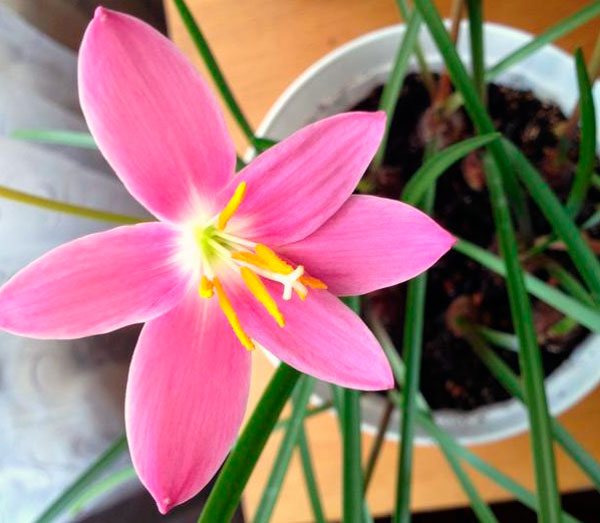

But the upstart home flower, being a tropical plant, is very positive about the high humidity of the air. Spraying is especially important in hot summer.
When caring for an upstart flower, fertilizing with ordinary mineral fertilizers is carried out every 7-10 days throughout the entire flowering period. For these purposes, a standard complex for flowering indoor plants is suitable. The dosages should be guided by the manufacturer's instructions. And when the flowering is over, a dormant period begins (a kind of hibernation), and at this time the plant does not need additional feeding.
How Zephyranthes is transplanted
Zephyranthes should be replanted in the spring as soon as the dormant period ends. Florists did not come to a consensus regarding the frequency of this procedure. Some of them advise replanting flowers annually, simultaneously planting them by separating mature bulbs from the mother. However, other florists argue that zephyranthes bloom much better in cramped conditions and does not like frequent transplants. therefore do not repot marshmallows in new pots too often - only as necessary or if desired to increase the number of copies.
A zeferanthes transplant is made in a low and not too spacious container. However, it can be wide if you want to place several bulbs in it at once - by the way, the upstart will like such a close neighborhood. When deepening the bulbs, make sure that the necks remain on the surface. There should be a good drainage layer at the bottom. The substrate needs a loose and nutritious, pH level of about 6. One of the options for a suitable composition: turf, humus and sand in equal quantities.
After transplantation, zephyranthes are watered sparsely so as not to cause rotting of the bulb.
Why isn't Zephyranthes blooming?
As it was written above, often the upstart flower does not bloom, if it is planted in a spacious container, it is often transplanted and seated. In this case, his energy is spent on the growth of roots and stems, and there is no longer any energy left for flowers. Therefore, first of all, try planting the upstart flower in a tighter pot and do not transplant it for a while, and also do not separate the plant bulbs.
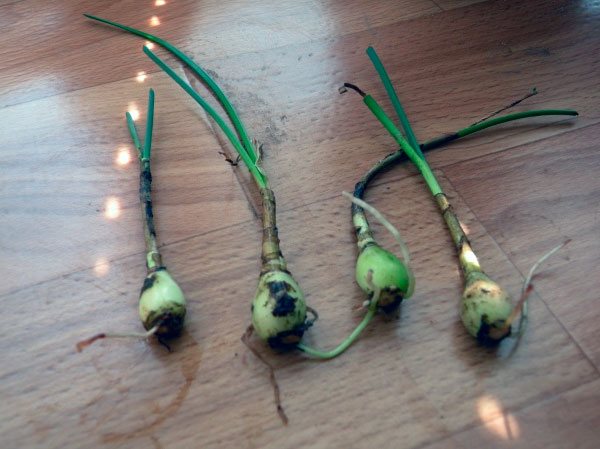

The reasons may lie in the wrong arrangement of the flower. In this regard, it is better to avoid extremes. For example, although the upstart loves the bright sun, constant exposure to scorching direct rays can cause a lack of flowers.
However, by placing the flower on the dark northern window, you also will not wait for the buds to appear - for this, the zephyranthes will not have enough light. Best of all is bright, but slightly diffused sunlight.
Zephyranthes often do not bloom due to overfed soil or due to high temperature and humidity during the dormant period. What to do in this case is described above.
How to properly propagate zephyranthes
Planting zephyranthes with bulbs is carried out most often - this method is the simplest, most reliable and self-evident. Each time, transplanting the zephyranthes into a new container, more or less grown children are separated from the mother's bulb. Planting zephyranthes bulbs is carried out in the fall, they are planted in a separate container filled with soil of the same composition as for adult specimens. Toddler marshmallows need well-fertilized soil and plenty of lighting. Under favorable conditions, young upstarts will delight with flowers next season.
You can also buy Zephyranthes bulbs at flower shops. Their price usually fluctuates around 50-70 rubles. However, if you intend to plant many upstart flowers, you should pay attention to wholesale stores, where you can buy a dozen bulbs for about 130-150 rubles.
Seed propagation is much more laborious and ineffective., and it is rarely used at home. This requires artificial pollination and waiting for seeds to ripen for two months. After this period, the seeds must be planted as soon as possible, because they quickly lose their germination.
If you are looking to buy Zephyranthes seeds from the store, also pay attention to the expiration date and packaging date of the product - expired seeds can be very ineffective. The price of a packet of seeds is on average 50 rubles, 10 rubles per seed.
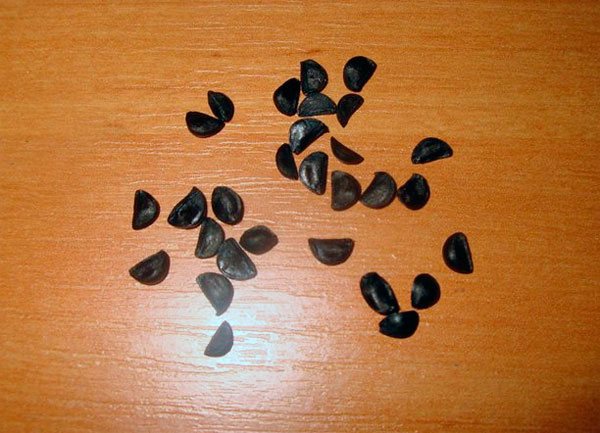

The soil for sowing is the same as for the bulbs, but with the addition of 1 part of peat.
The ground needs to be moistened, leveled and sown seeds every 2-3 cm. Cover the container with transparent polyethylene and put in a moderately shaded place, trying to adjust so that the temperature inside the greenhouse is kept at 22 degrees. The soil must be regularly moistened.
Sprouts will appear after 3-4 weeks, but young marshmallows will bloom only in the third year after planting.
Pests, diseases and control of them
The plant is practically not susceptible to attacks by harmful insects. It is extremely rare for it to be attacked by the ubiquitous scale insects, aphids or spider mites. You can get rid of pests by treating the flower with a solution of any flower insecticide. Treatment with a concentrated soap solution helps with aphids. But this method is effective only in the case of a minimal number of insects on the plant.
Zephyranthes has natural strong immunity. Therefore, the only disease that he can undergo is bulb rot. The disease provokes the wrong approach to plant care. There are several reasons for the occurrence of rot. The most common are:
- excessive soil moisture, which leads to stagnation of moisture;
- untimely draining of excess water from the pot tray;
- poorly lined drainage layer or lack thereof;
- the use of dirty tools when planting, transplanting a flower;
- ingress and stagnation of moisture in the leaf axils of the plant.
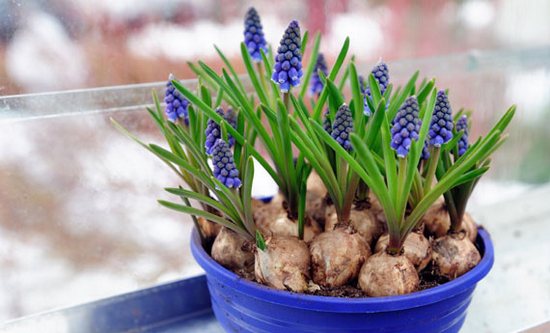

You may be interested in:
Muscari: planting and care in the open field, photo Muscaria is a spring flower that begins to bloom along with the first snowdrops. For some reason, among the people, too ... Read more ...
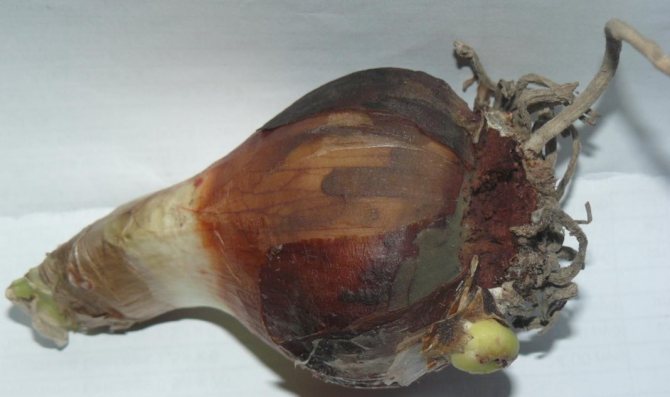

Onion rot
You need to fight rot by repeatedly treating the plant with a solution of any garden fungicide. To prevent the disease, before planting, the zephyranthes bulbs are dipped in a weak aqueous solution of potassium permanganate for half an hour.


